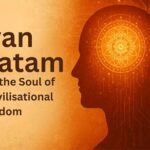
In Advaita Vedanta, the relationship between Brahman and Atman is profound. Let’s explore their significance:
- Brahman:
- Brahman is the ultimate reality, often described as the supreme consciousness.
- It transcends all limitations, forms, and descriptions.
- Nirguna Brahman refers to the formless aspect of Brahman, beyond conceptualization.
- Saguna Brahman (or Ishvara) is Brahman with form, often equated with God.
- Atman:
- Atman is the individual self, the essence of consciousness within each living being.
- According to Advaita Vedanta, Atman is identical to Brahman.
- The Mahavakya “Tat Tvam Asi” (meaning “You Are That”) emphasizes this non-difference.
- Key Points:
- Non-Duality: There is no distinction between Atman and Brahman.
- Unity: Atman is a mere reflection or limitation of singular Brahman in individual bodies.
- Moksha: Liberation is attained by recognizing the illusory nature of the world and realizing one’s true identity as Atman-Brahman.
The relationship between Brahman and Atman is a central and nuanced topic in Hinduism, with different schools of thought offering varying interpretations. Here’s a breakdown of the key points:
Similarities:
- Both are eternal and unchanging realities.
- Both are considered aspects of the ultimate truth.
- Both are associated with the concepts of “being,” “consciousness,” and “bliss” (Sat-Chit-Ananda).
Differences:
- Universality vs. Individuality: Brahman is the universal, all-encompassing reality, the one without a second. Atman, on the other hand, refers to the individual self or soul within each living being.
- Transcendence vs. Immanence: While Brahman is often described as both transcendent (beyond the universe) and immanent (present within everything), Atman is primarily seen as the immanent aspect, the spark of the divine within each individual.
Key Philosophical Interpretations:
- Advaita Vedanta (Non-dualism): This school emphasizes the ultimate unity of Brahman and Atman. They believe that Atman, when free from illusion (Maya), is ultimately identical to Brahman. The famous phrase “Tat Tvam Asi” (That Thou Art) expresses this idea.
- Dvaita Vedanta (Dualism): This school maintains a distinct separation between Brahman as the personal God and Atman as the individual soul. They believe in a relationship of love and devotion between the two.
- Vishishtadvaita Vedanta (Qualified Non-dualism): This school sees Brahman as a personal God containing and encompassing all individual souls (Atman) in a way similar to how a body has a soul.
Understanding Brahman and Atman can be a lifelong exploration within the vast philosophical landscape of Hinduism.
In summary, Atman and Brahman are fundamentally one, revealing the non-dualistic truth of existence. 🌟🕉️
For further exploration, consider studying the works of Adi Shankara and the Upanishadic statements that illuminate this profound connection123.

अमित एक अनुभवी आईटी अन्वेषक और सत्य के खोजी हैं। उन्होंने लिखने का माध्यम इसलिए चुना है ताकि आम लोगों तक अपने अनुभव साझा कर सकें।



